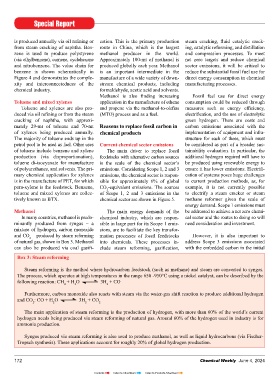Page 172 - CW E-Magazine (4-6-2024)
P. 172
Special Report
is produced annually via oil refining or cation. This is the primary production steam cracking, fluid catalytic crack-
from steam cracking of naphtha. Ben- route in China, which is the largest ing, catalytic reforming, and distillation
zene is used to produce polystyrene methanol producer in the world. and compression processes. To meet
(via ethylbenzene), cumene, cyclohexane Approximately 100-mt of methanol is net zero targets and reduce chemical
and nitrobenzene. The value chain for produced globally each year. Methanol sector emissions, it will be critical to
benzene is shown schematically in is an important intermediate in the reduce the substantial fossil fuel use for
Figure 4 and demonstrates the comple- manufacture of a wide variety of down- direct energy consumption in chemical
xity and interconnectedness of the stream chemical products, including manufacturing processes.
chemical industry. formaldehyde, acetic acid and solvents.
Methanol is also finding increasing Fossil fuel use for direct energy
Toluene and mixed xylenes application in the manufacture of ethene consumption could be reduced through
Toluene and xylenes are also pro- and propene via the methanol-to-olefins measures such as energy efficiency,
duced via oil refining or from the steam (MTO) process and as a fuel. electrification, and the use of electrolytic
cracking of naphtha, with approxi- green hydrogen. There are costs and
mately 29-mt of toluene and 70-mt Reasons to replace fossil carbon in carbon emissions associated with the
of xylenes being produced annually. chemical products implementation of equipment and infra-
The majority of toluene ends up in the structure for each of these, which must
petrol pool to be used as fuel. Other uses current chemical sector emissions be considered as part of a broader sus-
of toluene include benzene and xylene The main driver to replace fossil tainability evaluation. In particular, the
production (via disproportionation), feedstocks with alternative carbon sources additional hydrogen required will have to
toluene di-isocyanate for manufacture is the scale of the chemical sector’s be produced using renewable energy to
of polyurethanes, and solvents. The pri- emissions. Considering Scope 1, 2 and 3 ensure it has lower emissions. Electrifi-
mary chemical application for xylenes emissions, the chemical sector is respon- cation of systems poses huge challenges
is in the manufacture of PET, for which sible for approximately 6% of global to current production methods, as, for
para-xylene is the feedstock. Benzene, CO -equivalent emissions. The sources example, it is not currently possible
2
toluene and mixed xylenes are collec- of Scope 1, 2 and 3 emissions in the to electrify a steam cracker or steam
tively known as BTX. chemical sector are shown in Figure 5. methane reformer given the scale of
energy demand. Scope 1 emissions must
Methanol The main energy demands of the be addressed to achieve a net zero chemi-
In many countries, methanol is predo- chemical industry, which are respon- cal sector and the routes to doing so will
minantly produced from syngas – a sible in large part for its Scope 1 emis- need consideration and investment.
mixture of hydrogen, carbon monoxide sions, are to facilitate the key transfor-
and CO – produced by steam reforming mation processes of fossil feedstocks However, it is also important to
2
of natural gas, shown in Box 3. Methanol into chemicals. These processes in- address Scope 3 emissions associated
can also be produced via coal gasifi- clude steam reforming, gasification, with the embedded carbon in the initial
Box 3: Steam reforming
Steam reforming is the method where hydrocarbon feedstock (such as methane) and steam are converted to syngas.
The process, which operates at high temperatures in the range 650 -950°C using a nickel catalyst, can be described by the
following reaction: CH + H O 3H + CO
4
2
2
Furthermore, carbon monoxide also reacts with steam via the water-gas shift reaction to produce additional hydrogen
and CO : CO + H O 3H + CO 2
2
2
2
The main application of steam reforming is the production of hydrogen, with more than 60% of the world’s current
hydrogen needs being produced via steam reforming of natural gas. Around 60% of the hydrogen used in industry is for
ammonia production.
Syngas produced via steam reforming is also used to produce methanol, as well as liquid hydrocarbons (via Fischer-
Tropsch synthesis). These applications account for roughly 20% of global hydrogen production.
172 Chemical Weekly June 4, 2024
Contents Index to Advertisers Index to Products Advertised

